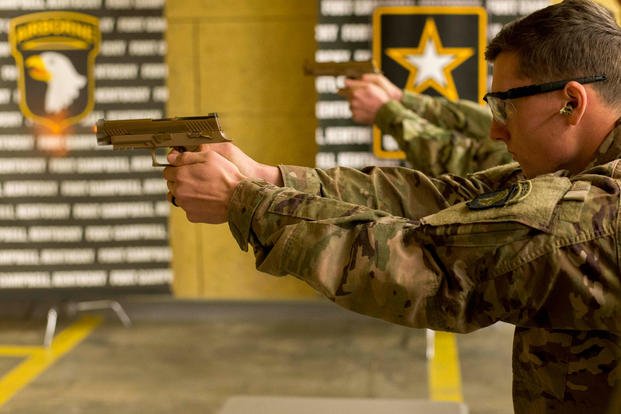Sig Sauer made a series of design tweaks to the Army Modular Handgun System last year that have improved the new pistol's reliability when firing 9mm ball ammunition, according to the newest annual report from the Pentagon's weapon's tester.
Both the XM17 and XM18 performed well firing jacketed hollow point ammunition but failed to meet some of the MHS reliability requirements with standard ball ammunition during the initial production verification tests, or PVT-T, the report said.
"The MHS experienced a large number of stoppages in early developmental testing with ball ammunition," according to the Fiscal 2018 Annual Report from the Defense Department's Director, Operational Test and Evaluation, released Jan. 31. "To improve the reliability with ball ammunition without degrading any of the other attributes of the weapon, the vendor made adjustments to the magazine spring, magazine follower, slide geometry, and the internal components."
Data from the Army Evaluation Center's analysis of PVT-2 reliability testing show that the changes made to pistol and magazine have led to improvements in MHS reliability with ball ammunition, the report states.
Both the XM17 and XM18 exceed the requirement of an average of 5,000 rounds between failures. The XM18, using both ball and jacketed hollow point ammunition, or JHP, exceeds the requirement of an average of 2,000 rounds between stoppages, according to the report.
The XM17 showed marked improvement during the second round of product verification testing but did not perform as well as the XM18. When using ball ammunition, it achieved an average of 1,566 rounds between stoppages, compared to the PVT-1 results of an average of 431 rounds between stoppages. When using JHP ammunition, the XM17 achieved an average of 1,880 rounds between stoppages, a decline when compared to the average of 2,709 rounds between stoppages it achieved in PVT-1, the report states.
The report states that XM17 demonstrated a 93-94 percent probability of "completing one 99-round mission without a single stoppage."
Just over a year has passed since the Army started fielding the MHS and, so far, the service has received 27,000 of the new striker-fired pistols that will replace the Cold War-era M9s in its inventory.
"At the end of next week, we will be over 30,000" Modular Handgun Systems delivered to the Army, Sig Sauer spokesman Joel Harris told Military.com on Wednesday evening. The company won the MHS contract in 2017.
The service, including Army Special Operations Command, intends to purchase approximately 233,429 MHS pistols, according to the DOT&E report.
Weapons officials recently fielded the new XM17 and XM18 the U.S. Army Military Police School (USAMPS) at Fort Leonard Wood, Missouri.
"The [Beretta M9s] we currently have are breaking more often, which causes readiness issues," Mark Farley, deputy commandant, said in a recent Army press release.
One of the most popular features on the MHS is its modular grips, which come in small, medium and large for different hand sizes, Farley said.
"The Military Police Corps is about 16 percent female soldiers, so this is a big deal when you're talking about soldier lethality and accuracy," Farley said in the release. "For all soldiers to be able to hold that weapon with a proper grip and use the right fundamentals of firing -- it's very important in order for them to be able to engage the target and thereafter. One size does not fit all."
Another popular feature of the MHS is its consistent trigger pull, said John Scarbrough, an instructor at USAMPS.
"Your first shot is the same as your 17th shot," he said in the release, adding that trigger pull in conjunction with the modular grips should improve accuracy among students.
"Those are the two biggest things that I think will help out whomever is shooting them," Scarbrough said in the release. "We have had students before who had to use two fingers to pull the trigger due to strength because of their hand position, or they're holding the gun in an awkward position so it's not managing recoil."
-- Matthew Cox can be reached at matthew.cox@military.com.










